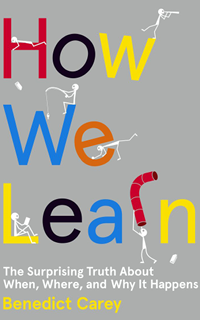Learning is a ‘restless, piecemeal, subconscious, and somewhat sneaky process,’ says a New York Times science reporter. We may have to relearn how to do it.
Reviewed by Allan Fallow

Near the end of this light-hearted take on a serious topic, Benedict Carey — a science reporter for The New York Times since 2004 — identifies five things we’ve been taught to believe are enemies of learning: distractions, interruptions, ignorance, restlessness and even giving up. All five are straw men he propped up earlier in How We Learn only to (convincingly) knock them down, and by the time we get to this recap, we’ve read enough of his you’ve-been-learning-it-wrong argument to know that he’s omitted a sixth, which happens to be my favorite: napping.
Carey wants to liberate learning from its status as a brute-force chore often done in isolation and blend it into “the more random demands of life.” He wants us to go about the task in such a way that we give our brains permission to toil on knotty problems “offline” — while we’re preoccupied with other activities, for example, or simply asleep.
In How We Learn, he presents the work of visionaries who are bringing more intuitive, more hands-on and more relaxed learning methods to the attention of the American public. “In the past few decades,” writes Carey, “researchers have uncovered and road-tested a host of techniques that deepen learning — techniques that remain largely unknown outside scientific circles.”
Why haven’t these small alterations in how we study or practice entered the mainstream? Because they are so contrary to what’s been drummed into our heads all our lives about best practices for learning — “Find a quiet place to study,” for example, or “Don’t let anything interrupt you” — that we doubt they will work. Who knew, for example, that varied practice (or “interleaving”) outstrips the focused kind, or that disrupted study sessions lead to better performance?
Forget About It
Consider the act of forgetting. Not something you’d boast about as an educational stratagem, right? As Carey puts it, “The world is so full of absentmindedness, tuned-out teenagers, misplaced keys and fear of creeping dementia that forgetting feels dysfunctional, or ominous.” But to forget is not necessarily to fail: Not only does it strengthen subsequent learning to revisit forgotten material, but forgetting suppresses “background noise,” or competing information, allowing the correct signals to stand out. This distinguishes forgetting as “nature’s most sophisticated spam filter,” in Carey’s phrase. “It’s what allows the brain to focus, enabling sought-after facts to pop to mind.”
The new learning research is likewise demolishing the “consistency doctrine” — the one about following the same study ritual each time, or using earplugs or a headset to block out background noise. Instead, a new theory about optimum recall, known as reinstatement, holds that having some sort of stimulus in the study environment, typically music, is better than dead silence. “The background music weaves itself subconsciously into the fabric of stored memory,” Carey explains.
“So much for the sanctity of the quiet study room.”
Breaking up study time — a technique known as “distributed learning” or “the spacing effect” — likewise has huge advantages over trying to absorb everything about a topic in one concentrated crunch. This explains why students who pull all-nighters typically show up for the second term of a class unable to recall anything from the first. “It’s a little like overstuffing a cheap suitcase,” Carey observes. “The contents hold for a while, then everything falls out.” But he also vents his legitimate outrage that a principle this powerful has not enjoyed a “quick, clean ride from the lab into classrooms.”
For much of the last 100 years, psychologists have — exasperatingly, inexplicably — confined the study of [the spacing effect] to short lab experiments. It’s as if doctors discovered a cure for diabetes and spent 50 years characterizing its molecular structure before giving it to a patient.
Readers subject to the sort of industrial-strength distractability that happens to afflict this reviewer will find special solace in Carey’s chapter on the role that “incubation” or “percolation” play in problem-solving. Although the author claims he had to beg his way into the University of Colorado, he did well enough there to graduate with a degree in mathematics. So it feels natural to find him quoting German physicist Hermann von Helmholtz on the wisdom of abandoning a thorny problem: By literally walking away from his work table whenever he hit a mental roadblock, Helmholtz discovered that new ideas “came particularly readily during the slow ascent of wooded hills on a sunny day.”
Free Association
English educator Graham Wallas devoted his professional life to the question of why critical insights hit us precisely when we are not working on a problem. Some kind of internal mental process, he conjectured, must be operating “that associates new information with past information. A type of internal reorganization of the information seems to be going on without the individual being directly aware of it.” So the next time your boss catches you daydreaming, explain that you were in fact incubating a business problem — a less intense but often more effective way of subconsciously continuing active work.
When the author himself hits a snag, he reveals, his incubations take the form of blasting music through a pair of headphones, walking around the block or roaming the hallways of The New York Times in search of some unsuspecting soul to whom he can complain. “I lose myself in the kvetching, I get a dose of energy, I return 20 minutes or so later, and I find that the intellectual knot, whatever it was, is a little looser.”
Nor does Carey claim the benefits of percolation exclusively for himself. If a quick hit of social media is all it takes to let the subconscious mind attack a problem on its own, writes Carey, “without the conscious brain telling it where to go or what to do,” then our creeping hysteria over the dangers of distracting digital products may be misplaced. “In this case,” Carey suggests, “distraction is not a hindrance: It’s a valuable weapon.”
The same goes for How We Learn.








